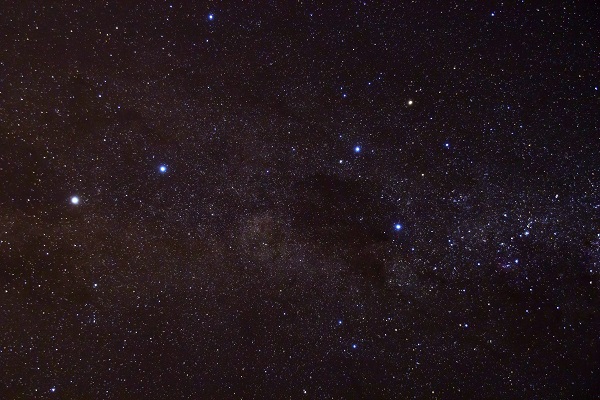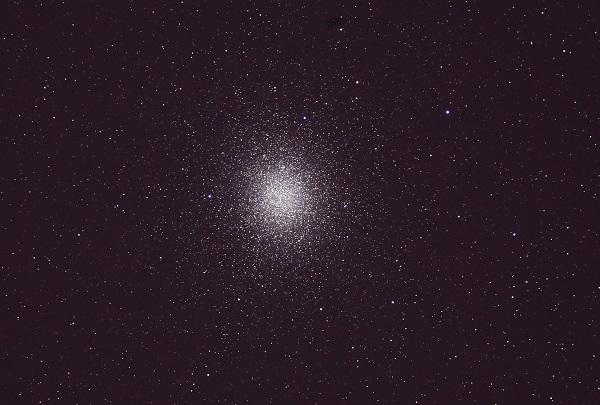By Geoffrey Wyatt
April is a great time of year to look for the Southern hemisphere’s most famous constellation and its nearby curiosities. The heat of summer is behind us and we often have some persistent clear nights to enjoy the heavens above. But of course when trying to see the sky you should have some fundamental supplies. If you can, go to a high location with a clear view to all points on the compass. Take a ground sheet to sit on, a blanket for warmth, perhaps a pillow, pair of binoculars if you have them, something warm to drink and your imagination to connect the dots.
 Crux by Geoff Wyatt
Crux by Geoff Wyatt
Nearly an hour after sunset from your high dark location look for any hint of twilight and you’re looking in the general direction of west. From there make a quarter turn to your left and look about 40degrees up (about two outstretched hand spans from pinkie tip to thumb tip). Look for the smallest of the 88 western constellations presently on its side. It is the Southern Cross or Crux. A relatively new constellation it has become a much loved icon of the southern hemisphere and now graces the flags of Australia, New Zealand, Papua New Guinea, Samoa and Brazil. It’s also useful and can be used to find south by extending the long axis of the cross by four and a half times to part of the sky close to the faint star Sigma Octantis (Mag 5.42 meaning not many folks can actually see it). From there drop straight down to the horizon and voilà you have south. Just below the cross you should be able to see two bright stars that point up to it at this time of year. They are the front hooves of the mighty centaur Chrion, the teacher of Achilles, Jason and Heracles. The lower and brighter of the two is Alpha Centauri and at just 4.3 light years away it is the closest star system to our Sun. Through a very good pair of binoculars or a small telescope you may be able to see that it is indeed two stars not one. There is a third star in orbit of these two but it’s too hard to see.
 Omega Centauri by Geoff Wyatt
Omega Centauri by Geoff Wyatt
The higher of the two pointers is also called Hadar and it is the stepping stone to finding one of the most beautiful objects in the sky, but you need to be looking on a dark moonless night. From Hadar look to your upper left (10pm on a clock face) to about 7 degrees away (a little less than a clenched fist at arm’s length) and the first bright star you come to is Epsilon Centauri. Continue in the same direction and about the same distance and scan the sky for a smudge. That smudge is one of the most beautiful objects in the sky. It is about 16,000 light years away and may contain as many as one million stars. We now think it may be the core of a small galaxy that was gravitationally ripped apart by our Milky Way. It is a densely packed ball of stars called a globular cluster. You will need binoculars, preferably on a tripod, or small telescope to see its beauty or perhaps you just need to visit an observatory like… Sydney Observatory to see its stunning structure. This particular cluster has several names but most commonly it is called Omega Centauri and I love it!
There are about 140 of these clusters associated with the Milky Way but this one rules the roost, it is simply stunning from a dark location.
If you wait a little longer, perhaps an hour or two you will see how the stars have all moved. Thanks rotating Earth! The Southern Cross is now nearly 60 degrees above the horizon. On a moonless night away from any town or city lights look just below the cross and you might notice a cloud of gas and dust blocking the light from the stars beyond. It’s about 600 light years away and 20 light years across and called the Coal Sack. This is our opportunity to sample some of the oldest star culture on the planet. The Indigenous peoples of Australia have been looking at the stars and using them in their culture for longer than any other on the planet, how cool is that? To some language groups this dark patch represents the head of a magnificent emu. Its long neck is also made of dark patches against the Milky Way which flows down to the east where it suddenly widens as the dark body (lack of stars) becomes visible near the famous western constellation of Scorpius. A few more hours are needed for the body to fully rotate into view but it’s worth wait. To the Boorong of the Wergaia language group in Victoria this is Tchingal while to the Kamilaroi and Euahlayi of northern NSW it is Gawarrgay. As far as I know the Indigenous peoples of Australia and some of South America are the only ones to make note of the dark patches in the sky in this way. To say I am honoured to learn even a little of this ancient knowledge is an understatement and something I wish we could all share.
Whatever you see in the night sky is incredibly beautiful, if only we take the time to turn off the lights and look up.
My name is Geoffrey Wyatt and I started work at Sydney Observatory in 1986. I have been here ever since with a few extended trips to live in Japan and later Uluru in central Australia. It was here that I first encountered the wonder of Aboriginal astronomy. As the Education officer at the Observatory and more recently one of the Education Program Producers for the Museum of Applied Arts and Sciences it is my desire for us all to see the sky as a significant natural and cultural resource which is just as important as any other resource on our wonderful planet.







